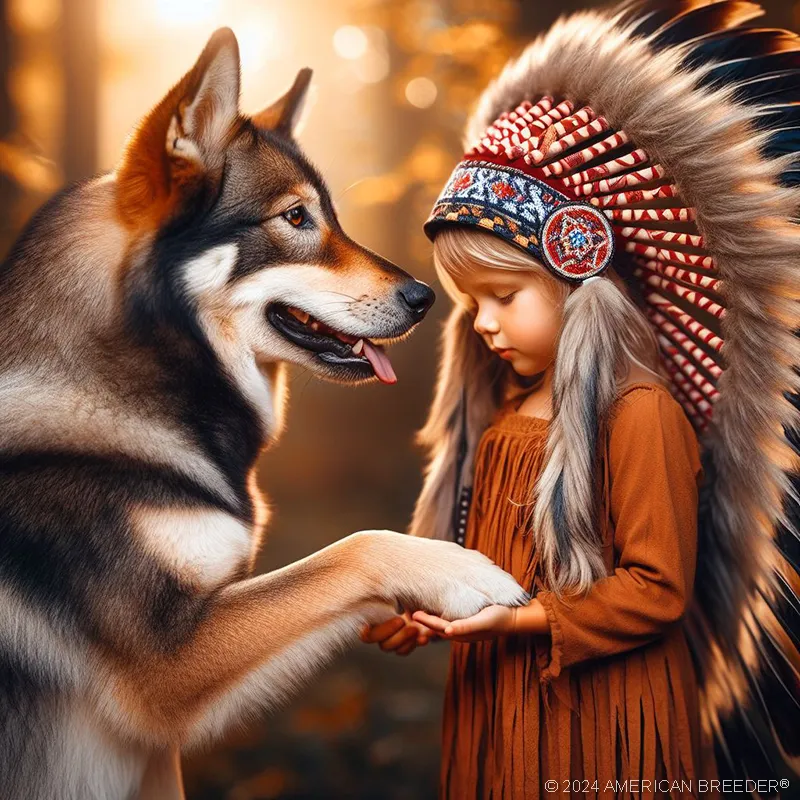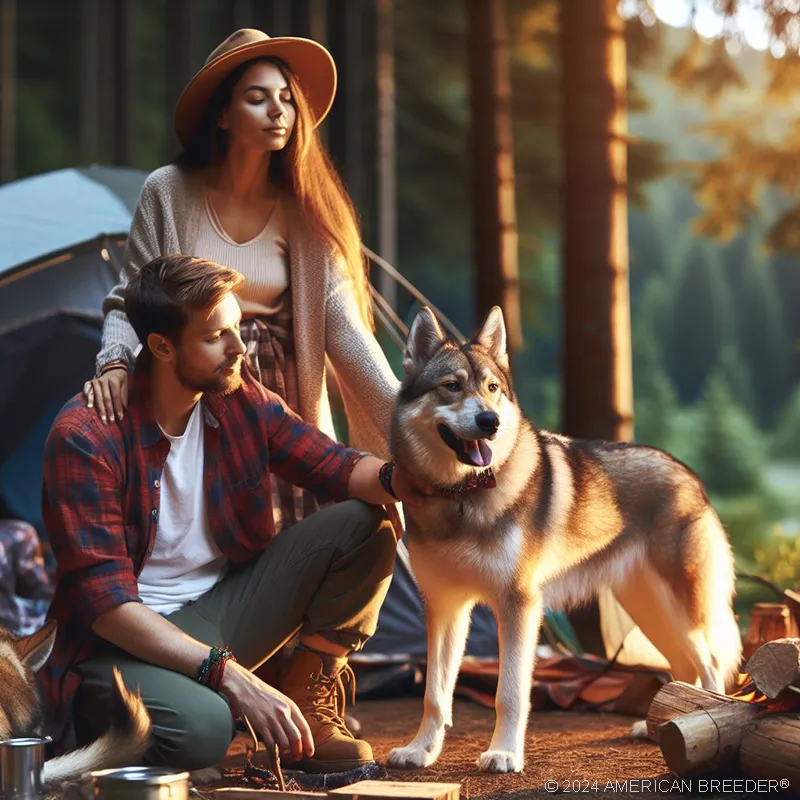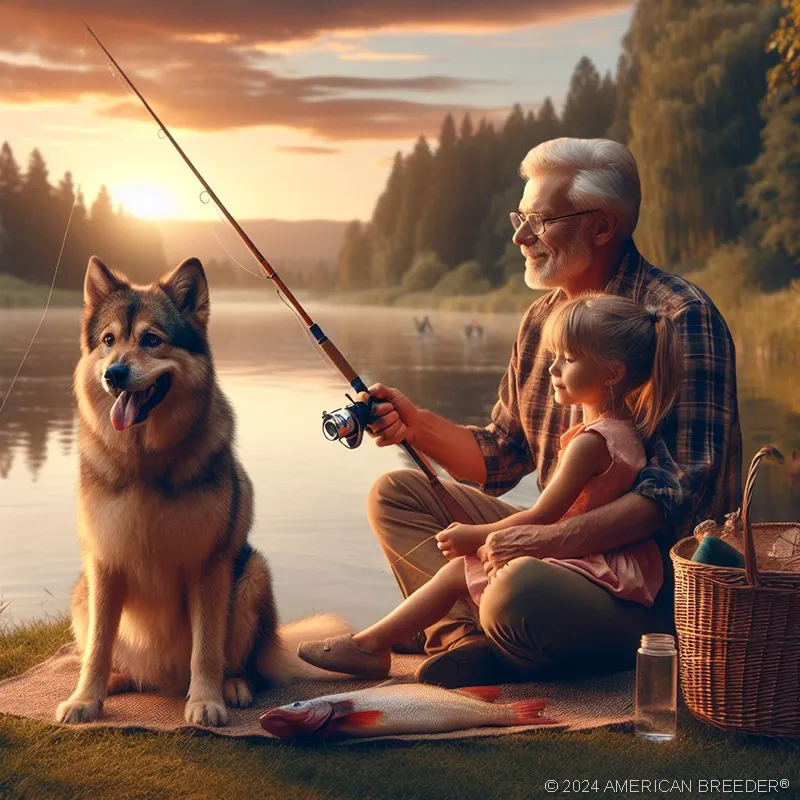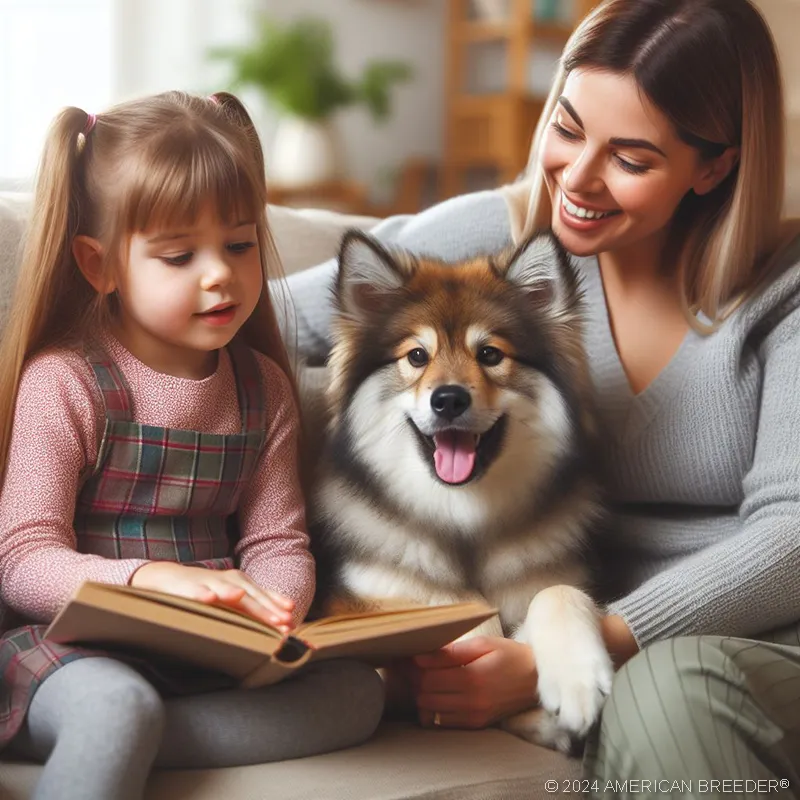The Native American Indian Dog Legacy: An Authoritative Guide
The Mystique of the Native American Indian Dog
 The allure of the Native American Indian Dog (NAID) is undeniable. From their wolf-like appearance to their storied history, they represent a blend of raw wilderness and ancient tradition. The breed, however, is more than just a fascinating aesthetic; the NAID is a tapestry of tales, experiences, and roles that have evolved over centuries.
The allure of the Native American Indian Dog (NAID) is undeniable. From their wolf-like appearance to their storied history, they represent a blend of raw wilderness and ancient tradition. The breed, however, is more than just a fascinating aesthetic; the NAID is a tapestry of tales, experiences, and roles that have evolved over centuries.
Origins: A Deep Dive into the Past
The roots of the NAID trace back to prehistoric times, when ancient tribes crossed the Bering Land Bridge, bringing their loyal canine companions along. These early dogs were integral to tribal life, assisting with hunting, guarding settlements, and serving as spiritual symbols in various tribes. Their resilience and adaptability meant they could thrive in diverse environments, from sweltering deserts to icy terrains.
While artifacts, cave paintings, and oral histories hint at their storied past, it's also important to note the modern-day NAID's lineage. The breed, as we recognize it today, is not purely the result of natural evolution but rather a recreation, aiming to encapsulate the essence of the ancient dogs using a blend of breeds. However, even through this process of recreation, the soul of the NAID remains untouched, reflecting loyalty, intelligence, and a deep bond with humans.
Physical Attributes: A Mesmerizing Sight
Possessing a striking appearance reminiscent of their wild ancestors, the NAID boasts a well-balanced body, a thick double coat, and piercing almond-shaped eyes. Their sizes can vary, but their stature always exudes a sense of majesty. Their coat, which requires regular grooming, can come in various colors, each with its own unique charm.
Their wolf-like demeanor isn't merely for show; it's a testament to their hardy nature and survival instincts. However, beneath that robust exterior lies a heart full of affection and a disposition that's both loyal and gentle.
Temperament: The Gentle Guardian
 Contrary to what their wild appearance might suggest, NAIDs are known for their gentle and protective nature. They are incredibly loyal to their families and often exhibit a keen sense of intuition about potential dangers. This blend of gentleness with an alert disposition makes them excellent companions for families, even those with children.
Contrary to what their wild appearance might suggest, NAIDs are known for their gentle and protective nature. They are incredibly loyal to their families and often exhibit a keen sense of intuition about potential dangers. This blend of gentleness with an alert disposition makes them excellent companions for families, even those with children.
It's worth noting that their intelligence also means they need regular mental stimulation. Engaging toys, training sessions, and interactive activities are crucial to keep a NAID both happy and mentally fit.
Diet and Nutrition: Fueling the Wilderness Spirit
The NAID, historically, thrived on a diet rich in protein and natural fats. Modern commercial foods can cater to their needs, but it's essential to ensure these are high-quality, prioritizing genuine meat ingredients. A balanced diet, occasionally supplemented with fish oils or other natural sources of omega fatty acids, ensures a glossy coat and healthy skin.
Considering their active nature, their caloric needs might slightly tilt higher. However, monitoring their weight and maintaining a balanced diet is paramount to ensure optimal health.
Training and Behavior: Harnessing their Potential
Given their intelligence and instinct-driven nature, NAIDs respond well to positive reinforcement training methods. Their keen sense of understanding and alertness can make them easy to train, but it's also essential to begin this process early. Socialization, in particular, plays a crucial role in molding their temperament, ensuring they grow into well-rounded adults.
However, like any breed, the NAID can develop behavioral quirks if not adequately trained or if left unattended for prolonged periods. Regular engagement, a structured routine, and consistent training can ensure they remain well-behaved and content.
Health and Medical Insights
 The Native American Indian Dog's robust genetics, stemming from its rich lineage, generally imparts a strong constitution. However, as with all breeds, they aren't immune to specific health conditions. NAIDs can be predisposed to common canine ailments like hip dysplasia, certain eye conditions, and allergies. Regular check-ups, a keen eye for changes in behavior, and a holistic approach to their well-being can go a long way in ensuring their longevity and vitality.
The Native American Indian Dog's robust genetics, stemming from its rich lineage, generally imparts a strong constitution. However, as with all breeds, they aren't immune to specific health conditions. NAIDs can be predisposed to common canine ailments like hip dysplasia, certain eye conditions, and allergies. Regular check-ups, a keen eye for changes in behavior, and a holistic approach to their well-being can go a long way in ensuring their longevity and vitality.
Moreover, the genetic diversity within the breed can sometimes act as a buffer against hereditary diseases, a blessing derived from their rich ancestry. To maintain this health advantage, regular vaccinations, preventative treatments for parasites, and periodic screenings for potential hereditary conditions are recommended.
Exercise and Physical Activity
The vibrant spirit of the NAID demands an outlet. Historically bred for tasks that required stamina, agility, and intelligence, their energy levels remain high. Regular walks, coupled with free play in a secure yard or open space, can help satiate their activity needs. Their agile nature also makes them excellent companions for activities like hiking, jogging, or even agility training.
However, the mental stimulation accompanying these activities is just as crucial. Games that challenge their intellect, like puzzle toys or hide-and-seek, can be beneficial. Their heritage as working dogs means they appreciate tasks and challenges, so integrating these into their daily routine can be both fulfilling and fun.
Grooming Essentials
Their thick double coat, a remnant of their wild ancestry, requires consistent grooming to stay in prime condition. Regular brushing not only helps in detangling but also aids in distributing natural oils, ensuring a healthy sheen. During shedding seasons, this regimen might need to be intensified.
Beyond coat care, attention must also be directed towards their nails, ears, and dental health. Regular nail trims, ear cleaning, and dental check-ups will ensure they remain in top health, from head to paw.
Cultural Significance and Legacy
 To truly appreciate the NAID, one must understand their cultural and spiritual significance. For many Native American tribes, these dogs were more than mere companions or workers; they were symbols of strength, loyalty, and spirituality. Some tribes believed these dogs were spiritual guardians, protecting tribespeople from negative forces.
To truly appreciate the NAID, one must understand their cultural and spiritual significance. For many Native American tribes, these dogs were more than mere companions or workers; they were symbols of strength, loyalty, and spirituality. Some tribes believed these dogs were spiritual guardians, protecting tribespeople from negative forces.
Their roles in tribal rituals, their representation in artifacts, and their place in oral histories underscore their profound significance. Owning a NAID isn't just about having a pet; it's about preserving a legacy, understanding a rich cultural tapestry, and appreciating the deep bond between humanity and nature that the breed represents.
Training and Behavioral Insights
Diving deep into the psyche of the Native American Indian Dog, it becomes clear that this breed’s heritage plays a significant role in its demeanor. Naturally inclined to be loyal, the NAID thrives on strong bonds with its human counterparts. However, their innate intelligence, coupled with a hint of their wild ancestry, means they can sometimes exhibit an independent streak.
Training a NAID requires a balanced approach: firmness combined with kindness. Positive reinforcement techniques work wonders, allowing them to understand their role within the family hierarchy while also keeping their spirits high. Socialization, from an early age, is crucial. Due to their protective nature, introducing them to various environments, people, and other animals can help in ensuring they grow up to be well-adjusted adults.
Understanding canine ethology is invaluable here. The NAID's communication, often subtle, can provide vital cues. Tail positioning, ear orientation, and vocalizations all offer insights into their mental state. Being attuned to these nuances can facilitate a more harmonious coexistence and more effective training.
However, behavioral issues can sometimes arise. Like any dog, the NAID can develop anxieties or display territorial tendencies. Seeking insights from veterinary behavior specialists can be beneficial, offering tailored solutions that respect the breed's unique temperament.
Dietary and Nutritional Recommendations
The essence of the Native American Indian Dog's well-being, like any canine, lies significantly in its diet. Historically, these dogs would have thrived on a diet rich in proteins, derived from sources available in their native lands. Thus, ensuring a diet that mirrors their ancestral needs can be pivotal.
High-quality dog foods that prioritize meat as the primary ingredient are ideal. Given their active nature, they require a diet that can sustain their energy levels, rich in proteins and essential fats. Moreover, being alert to potential allergies is crucial. Regular check-ins with a veterinarian specializing in canine nutrition can help tailor a diet plan that ensures the NAID's longevity and health.
Supplements can also play a role, especially for older dogs or those with specific health needs. However, it's essential to consult with a veterinarian before introducing any supplements to their diet.
The Role of Genetics and Breeding
 The Native American Indian Dog's lineage is a tapestry of rich genetic diversity. However, understanding these genetics can offer invaluable insights, especially for potential breeders. The breed's origins, tracing back to ancient indigenous dogs, means they carry a unique set of genetic markers.
The Native American Indian Dog's lineage is a tapestry of rich genetic diversity. However, understanding these genetics can offer invaluable insights, especially for potential breeders. The breed's origins, tracing back to ancient indigenous dogs, means they carry a unique set of genetic markers.
For breeders, responsible practices are paramount. Ensuring genetic diversity, avoiding inbreeding, and being aware of potential hereditary conditions are all crucial. Genetic screenings, pedigree analysis, and consultations with canine geneticists can aid in making informed decisions, ensuring the breed's health and sustainability for future generations.
Medical and Health Considerations
The Native American Indian Dog, with its robust constitution, is often lauded for its longevity and general resistance to many common canine ailments. Their ancestors thrived in the wild, facing diverse environmental challenges, which bequeathed them with a hardy constitution. Yet, like all breeds, there are certain health considerations that prospective and current owners should be cognizant of.
Regular check-ups with a vet who is well-versed in the specific needs of the NAID can play a pivotal role in preemptive health care. Regular screenings, vaccinations, and flea/tick preventatives form the crux of this. While the breed is generally healthy, they can occasionally be prone to hip dysplasia, a hereditary condition where the hip joint doesn't develop correctly. It's essential to ensure that breeders screen for this condition before breeding.
Dental health, often overlooked, is another focal point. Regular brushing, dental treats, and periodic professional cleanings can ward off potential issues, ensuring oral health and overall well-being.
Grooming and Maintenance
The Native American Indian Dog's coat, with its luxurious, dense texture, is a sight to behold. Their double coat can range from short to medium in length, with a variety of colors and patterns. While they do not shed excessively, they do have shedding seasons that require a more diligent grooming regimen.
A weekly brush, to keep their coat tangle-free and glossy, becomes especially crucial during shedding seasons, preventing matting and facilitating the removal of loose fur. A quality brush designed for double-coated breeds can be a godsend.
Beyond their coat, attention should be directed towards their nails, ears, and eyes. Regular nail trims, ear cleanings, and periodic eye checks can ensure that they remain in prime health, catching potential issues before they escalate.
Breed's Cultural and Historical Significance
 Delving into the annals of history, the Native American Indian Dog's legacy intertwines with that of the indigenous peoples of North America. They weren't merely pets but partners in the truest sense, aiding in hunting, herding, and even serving as warm companions during the frigid nights.
Delving into the annals of history, the Native American Indian Dog's legacy intertwines with that of the indigenous peoples of North America. They weren't merely pets but partners in the truest sense, aiding in hunting, herding, and even serving as warm companions during the frigid nights.
Historical records, cave paintings, and oral traditions all hint at their esteemed position within various tribes. Their keen senses, agility, and unyielding loyalty made them indispensable. Over the centuries, their roles evolved, mirroring the changing landscapes and lifestyles of their human counterparts.
Modern times have seen a resurgence in interest regarding the NAID, both as a testament to a time gone by and a cherished companion for the present. Their cultural significance remains undeniable, serving as a living link between the past and the present.
Nutritional Needs and Diet
The Native American Indian Dog is a highly active breed, and as such, requires a diet that can keep up with its energy demands. Rooted in their history, these dogs would often forage and hunt, feasting on a diet rich in proteins. Today, the principles remain the same. A balanced diet with high-quality proteins, essential fats, and complex carbohydrates can ensure their optimal health.
Owners must be mindful of the quality of commercial dog foods they offer. Brands that list real meat as their primary ingredient, devoid of fillers and artificial additives, tend to be more suited to the nutritional profile the NAID needs. For those inclined towards homemade diets, consulting a canine nutritionist can be beneficial, ensuring that all essential nutrients are adequately represented.
Moreover, due to their high activity levels, the NAID may consume more food than an average dog of their size. However, owners must keep a keen eye on their dog's weight, as obesity can lead to a myriad of health issues. Regularly monitoring their weight and adjusting food quantities accordingly is crucial.
Training and Behavioral Insights
The NAID's intelligence is one of its hallmark traits. Their quick wit and eagerness to please make them highly trainable. However, their independent streak, inherited from their wild ancestors, means that consistency is key. Positive reinforcement techniques, combined with firm yet gentle guidance, yield the best results.
Socialization, starting from a young age, can ensure that they grow into well-adjusted adults. Exposure to various people, environments, and other animals can inculcate confidence and reduce any potential aggressive or fearful tendencies.
Despite their trainability, the NAID's keen senses can sometimes be a double-edged sword. They can get easily distracted by intriguing scents or sounds. Hence, recall training, ensuring that they come back when called, becomes paramount, especially if they are to be let off-leash.
Activities and Exercise
 The NAID is not a breed content with being a couch potato. Their energy levels require regular outlets, making daily exercise a non-negotiable. Long walks, coupled with play sessions, can keep them physically engaged. Mental stimulation, given their intelligence, is equally crucial. Interactive toys, agility courses, and even obedience training sessions can serve this purpose.
The NAID is not a breed content with being a couch potato. Their energy levels require regular outlets, making daily exercise a non-negotiable. Long walks, coupled with play sessions, can keep them physically engaged. Mental stimulation, given their intelligence, is equally crucial. Interactive toys, agility courses, and even obedience training sessions can serve this purpose.
Their ancestral lineage also means they excel in activities that mimic traditional tasks. Herding, tracking, and even search and rescue operations are areas where the NAID shines. Such activities not only provide physical exertion but also cater to their innate instincts and abilities.
History and Origins
Diving deep into the annals of history, the Native American Indian Dog's (NAID) tale is deeply intertwined with that of the indigenous tribes of North America. This breed wasn't just a mere pet; it played an integral role in the daily lives of Native Americans, serving multifarious purposes from hunting and tracking to guarding tribal settlements.
The NAID's ancestors are believed to have crossed the Bering Strait alongside ancient human populations, thousands of years ago. These dogs were adept hunters and gatherers, complementing the nomadic lifestyle of the tribes. Historical documentation, tribal legends, and archaeological finds all attest to the existence of these dogs, painting a vivid picture of a loyal companion that stood by humanity's side, facing the harshness of nature and challenges of survival.
Appearance and Physical Characteristics
The Native American Indian Dog’s appearance echoes its rich heritage. Often likened to wolves, they possess a regal and wild aesthetic. With almond-shaped eyes that can be any shade from amber to clear blue, their gaze is penetrating and intelligent.
Medium to large in size, the NAID’s muscular build supports its agile movements. Their double coat, which varies from short to medium length, is dense and can repel water, an evolutionary trait that equipped them to face varied climatic conditions. The colors of their coats are reminiscent of their natural surroundings, ranging from silver to tortoise shell and everything in between.
Their appearance, a blend of strength and grace, serves as a testament to their ancient lineage and the demanding environments they've adapted to over millennia.
Health and Genetic Traits
 Given their historical context of adapting to a variety of environments, the NAID is generally a robust breed with fewer health issues than some other breeds. However, responsible breeding practices are paramount to ensure the continuation of this strong genetic lineage.
Given their historical context of adapting to a variety of environments, the NAID is generally a robust breed with fewer health issues than some other breeds. However, responsible breeding practices are paramount to ensure the continuation of this strong genetic lineage.
Common health screenings for potential breeding pairs include checks for hip dysplasia, a condition prevalent in many larger dog breeds. Regular check-ups with a vet familiar with the breed can preemptively address potential issues like allergies or certain genetic conditions. An essential aspect to remember is that their genetic diversity, resulting from their rich history, often makes them less susceptible to many hereditary ailments seen in more homogenized breeds.
Grooming and Maintenance
The NAID's dense double coat demands regular grooming to ensure it remains clean and healthy. A weekly brushing routine can help in removing dead hairs and preventing matting. During their shedding seasons, which typically occur twice a year, more frequent grooming might be necessary.
Despite their seemingly rugged appearance, the NAID enjoys being pampered. Regular baths, nail trims, and dental check-ups not only ensure they look their best but also serve as preventive measures against potential health issues. Their natural coat repels dirt to some extent, which means they don't require frequent baths unless they've rolled in something particularly unpleasant.
Endearing Traits and Temperament
One cannot discuss the NAID without delving into their temperament. A blend of intelligence, loyalty, and a dash of independence defines them. Their history as working dogs means they're always eager for a task, be it physical or mental.
They form strong bonds with their human companions, often being protective. This protective nature doesn't inherently mean aggression; with proper socialization, they're known to be friendly even with strangers. Their high intelligence can sometimes be a challenge – a bored NAID can quickly become a mischievous one. Therefore, keeping them engaged mentally is as crucial as their physical exercise.
For families, the NAID can be a wonderful addition. Their gentle nature makes them excellent playmates for children. However, as with all breeds, supervision during playtimes with younger children is always advised.
In a nutshell, the NAID's temperament is a harmonious blend of their historical roles – a guardian, a hunter, and a loyal companion.
Training and Socialization
 The Native American Indian Dog’s intelligence is one of its hallmark traits. However, with great intellect comes the need for thoughtful and consistent training. Their cognitive prowess means they grasp commands quickly, but it also implies they might attempt to outsmart their human companions if boundaries aren't set early on.
The Native American Indian Dog’s intelligence is one of its hallmark traits. However, with great intellect comes the need for thoughtful and consistent training. Their cognitive prowess means they grasp commands quickly, but it also implies they might attempt to outsmart their human companions if boundaries aren't set early on.
Initiating training during their puppy stage is invaluable. Positive reinforcement techniques, which reward good behavior with treats or praise, have shown tremendous success with this breed. The NAID thrives on challenges, so varying training routines and introducing new tasks keeps them engaged. Remember, repetition and consistency are the pillars of successful training.
Socialization, like training, should commence early. Exposing young NAIDs to various environments, people, and other animals molds them into well-adjusted adults. Their innate curiosity, coupled with positive experiences during their formative months, ensures they grow into confident and amiable companions.
Diet and Nutrition
A dog's health is often a direct reflection of its diet, and the NAID is no exception. Given their active nature, they require a nutrient-rich diet to sustain their energy levels. Quality commercial dog foods, which list meat as a primary ingredient, are generally suitable. However, due to their sensitivity to some additives, it's crucial to choose brands free from artificial preservatives and fillers.
For those considering a raw or home-cooked diet, it's essential to consult a veterinarian or a canine nutritionist. These diets can be beneficial but require meticulous planning to ensure they're balanced. Including lean meats, vegetables, and whole grains while avoiding toxic foods like chocolates, grapes, and onions is key.
Regularly monitoring their weight and adjusting portion sizes based on activity levels is pivotal. Overfeeding can lead to obesity, which can, in turn, lead to myriad health issues.
Exercise and Recreation
An integral part of the Native American Indian Dog’s life is its need for regular physical activity. Their ancestors roamed vast terrains, hunted, and played vital roles within their tribes. This history has endowed the modern NAID with an abundant reservoir of energy.
Daily walks are essential, not just for physical exercise but also for mental stimulation. They relish the opportunity to explore new terrains, trace intriguing scents, and simply revel in the outdoors. For those with yards, play sessions with toys or fetching games can be both fun and physically rewarding for the dog.
However, their intelligence means they need more than just physical exertion. Puzzle toys, agility courses, or even simple obedience drills can provide the mental workout they crave. A well-exercised NAID, both mentally and physically, is a happy and content companion.
Role in Modern Society
 The versatility of the NAID makes it a sought-after breed in various roles in modern society. Beyond being loving family companions, they excel in therapy and service roles, thanks to their sensitivity and intelligence. Their keen sense of smell and agility also makes them suitable candidates for search and rescue operations.
The versatility of the NAID makes it a sought-after breed in various roles in modern society. Beyond being loving family companions, they excel in therapy and service roles, thanks to their sensitivity and intelligence. Their keen sense of smell and agility also makes them suitable candidates for search and rescue operations.
However, their deep-rooted bond with nature has made them ambassadors for various environmental causes. Their history, which mirrors the indigenous tribes’ respect for nature, serves as a poignant reminder of the symbiotic relationship between humans and the environment.
In many ways, the Native American Indian Dog stands as a testament to resilience, adaptability, and the age-old bond between humans and dogs. Through responsible breeding and understanding, we can ensure that future generations continue to learn from and cherish this remarkable breed.
Health and Longevity
A testament to their rugged heritage and natural evolution, the Native American Indian Dog typically boasts robust health. However, like all breeds, they're not entirely immune to health concerns. With a lifespan ranging from 12 to 14 years, these dogs tend to lead long, active lives when cared for appropriately.
Common issues that may affect NAIDs include hip dysplasia, a joint malformation that can lead to arthritis, and certain allergies, especially to artificial additives in food. Regular veterinary check-ups, a balanced diet, and moderate exercise can mitigate these concerns.
It's also essential to maintain routine health practices. This includes regular vaccinations, flea and tick treatments, dental check-ups, and grooming sessions. Monitoring their health and addressing potential issues promptly ensures that your NAID remains a healthy and active member of your family.
Grooming and Maintenance
The NAID's double coat, which protected its ancestors from harsh conditions, requires regular attention. While they are seasonal shedders, brushing their coat several times a week not only reduces the shedding but also ensures that their skin and coat remain healthy. Regular brushing distributes natural oils, removes dirt, and prevents matting.
Bathing is necessary only when the dog is particularly dirty or emits an odor. Over-washing can strip the coat of its natural oils. When bathing, always use dog-specific shampoos, preferably those made from natural ingredients to prevent skin irritations.
Other grooming essentials include regular nail trimming, ear cleaning, and dental care. A balanced diet can aid dental health, but brushing their teeth or providing dental chews helps prevent tartar build-up and ensures fresh breath.
The Breeding Perspective
 The resurgence in the popularity of the Native American Indian Dog brings along concerns related to ethical breeding. While the breed has a rich history, ensuring its continuation means responsible breeding practices.
The resurgence in the popularity of the Native American Indian Dog brings along concerns related to ethical breeding. While the breed has a rich history, ensuring its continuation means responsible breeding practices.
Prospective breeders should prioritize health screenings to ensure that only healthy dogs with good temperaments are bred. This not only safeguards the breed's future but also ensures that puppy buyers receive a companion free from preventable health and behavioral issues.
Educating potential buyers about the breed's characteristics, needs, and potential challenges is pivotal. This ensures that every NAID finds a forever home that understands and appreciates its unique qualities.
Training and Behavioral Insights
The Native American Indian Dog, with its lineage tracing back to ancient times, carries not just physical attributes of its forebears, but also certain behavioral traits. Being highly intelligent, the NAID can quickly pick up commands and routines. This intelligence, combined with their eagerness to please, makes them relatively easy to train. However, their independent nature requires a handler who can establish themselves as a confident leader.
Early socialization is a key aspect of their training. Given their instinctual protective streak, introducing them to various experiences, people, and animals at a young age ensures they grow up to be well-rounded, confident adults. This exposure helps reduce any overprotective tendencies and ensures that their natural caution doesn't evolve into unwarranted aggression or fear.
Given their history as working animals, the NAID thrives when given tasks or challenges. Activities like agility courses, scent tracking, or even herding can stimulate their minds and provide them with much-needed exercise. Their instinctual behaviors can be harnessed and directed in a positive way through structured training.
While their loyalty and protective nature make them excellent guard dogs, it's essential that they understand the distinction between friend and foe. Regular training sessions, combined with positive reinforcement techniques, are most effective for this breed. Harsh training methods can be counterproductive and damage the trust between dog and handler.
Nutritional Needs and Diet
An understanding of the NAID's ancient roots helps guide their nutritional requirements. In the wild, their diet would have consisted primarily of raw meats, some vegetables, and fruits. Providing a balanced diet that mirrors this natural inclination can ensure optimal health.
High-quality dog food, preferably with meat as the primary ingredient, serves their needs well. If considering a raw diet, it's essential to consult with a veterinary nutritionist to ensure all their nutritional requirements are met. Fresh water should always be readily available.
It's also worth noting that, like many breeds, NAIDs can be prone to obesity if overfed or under-exercised. Regular weight checks and portion control are essential. Additionally, avoiding foods with high grain content, artificial additives, or fillers can prevent potential allergies or digestive issues.
The Native American Indian Dog in Modern Culture
Today, the NAID is not just a companion but has also found its way into various facets of modern culture. Their striking appearance and rich history make them a favorite subject in literature and art. Their roles are not just limited to household companionship; many NAIDs have found purpose as therapy or service dogs, helping countless individuals with disabilities or emotional needs.
Their resilience, intelligence, and adaptability mean that, even in the urbanized 21st century, the NAID finds a place of relevance. Whether it's assisting a disabled individual, participating in dog sports, or simply being a beloved family pet, the NAID continues to leave an indelible mark on the human heart.
Native American Indian Dog Quick Reference Guide
Breed Background: Origin: Native America | Breed Purpose: Hunting, Guarding, Companionship | AKC Class: Not officially recognized | Year Recognized by AKC: N/A
 Appearance: Size: Medium to Large | Weight: 40-120 lbs | Coat Type: Double coat (Straight to slightly wavy outer coat) | Colors & Patterns: Sable, black, white, tortoiseshell, blue, and combinations | Distinctive Features: Almond-shaped eyes, webbed feet, spirit markings
Appearance: Size: Medium to Large | Weight: 40-120 lbs | Coat Type: Double coat (Straight to slightly wavy outer coat) | Colors & Patterns: Sable, black, white, tortoiseshell, blue, and combinations | Distinctive Features: Almond-shaped eyes, webbed feet, spirit markings
Temperament: Energy Level: 4 | Loyalty: 5 | Friendliness to Pets: 4 | Friendliness to Strangers: 3 | Trainability: 4 | Playfulness: 4 | Frequent Barker: 2 | Chase Instincts: 4 | Sense of Smell: 4 | Drive to Hunt: 4
Health & Care: Health Issues: Hip dysplasia, eye conditions | Lifespan: 12-19 years | Grooming Difficulty: Medium (more during shedding seasons) | Exercise Needs: High
Socialization: Interaction with Children: Good with supervision | Interaction with Pets: Generally friendly | Interaction with Strangers: Wary but not aggressive | Elderly Compatibility: Suitable with active elderly | Ease of Training: Moderately easy with consistency
Suitable Living Arrangements: Apartment: No | House: Yes | Rural Area: Yes | Yard Size Requirements: Medium to large fenced yard
Training & Obedience: Trainability: 4 | Intelligence: 4 | Obedience: 4 | Problem-Solving: 4 | Easily Stimulated: 3 | Focus Level: 4 | Easily Distracted: 3
Financial Planning: Typical Price Range: $1,000-$2,000 | Initial Expenses: Vaccinations, spaying/neutering, training, initial gear (leash, collar, crate) | Ongoing Annual Expenses: Vet check-ups, food, toys, grooming, and potential health treatments
Breeding: Reproductive Maturity: 6-9 months | Litter Frequency: 1 per year | Litter Size: 4-6 puppies | Stud Cost: Varies based on lineage, typically $500-$1,500 | Breeding Challenges: Ensuring genetic diversity, maintaining breed characteristics
Did You Enjoy this Article? Share it and Help Us Spread the Word!
If you found this article helpful, we'd appreciate it if you could share it with your friends or link to it from your website, blog, or group! You can also use the convenient social share tabs on the left side of the screen to instantly share this page to your social media feed. For more ways to support and promote the American Breeder Community, visit our Share & Promote Together page for social media posts and memes you can copy and share. Your support means the world to us!
Disclaimer: The information provided in this article is for general informational purposes only and does not constitute legal, medical, financial, or professional advice. While we strive for accuracy, we make no representations or warranties regarding the completeness, accuracy, reliability, or suitability of the information. Please consult with a professional before making decisions based on the content provided. American Breeder Inc. assumes no responsibility for any errors or omissions or for the results obtained from the use of this information.
